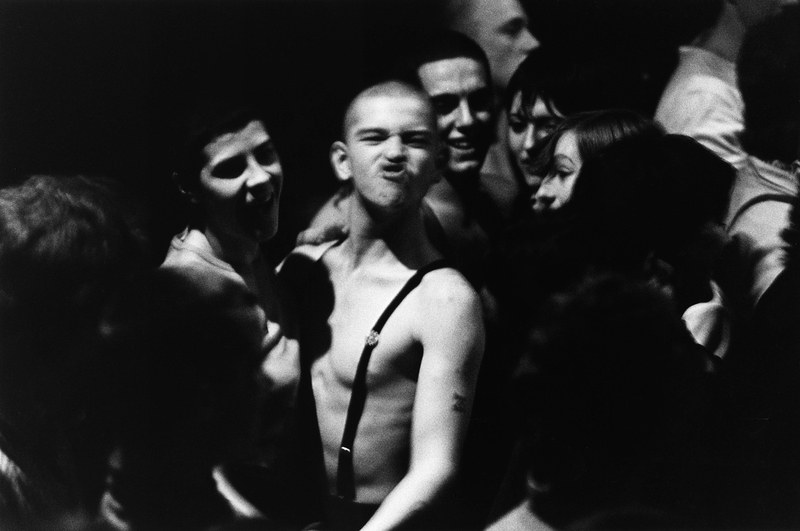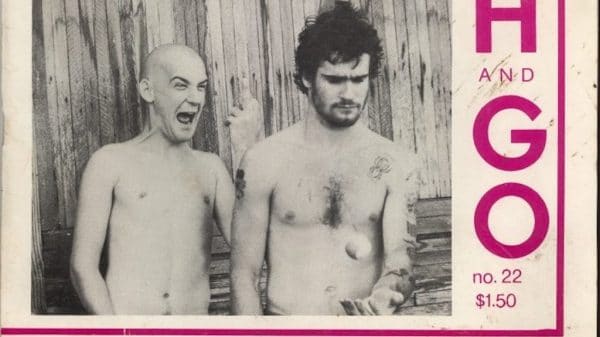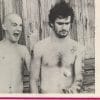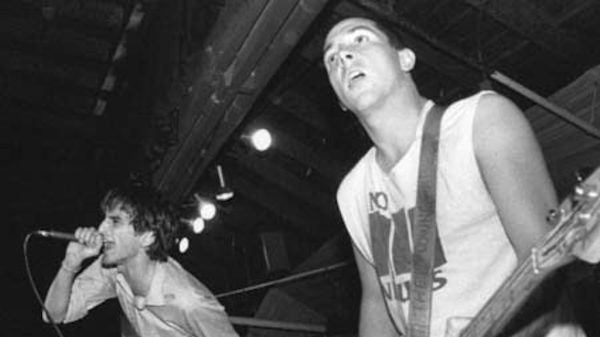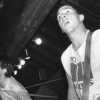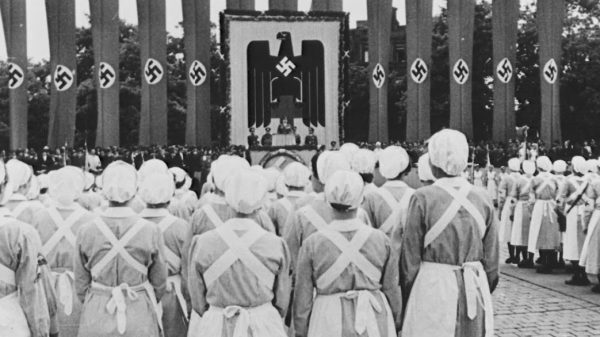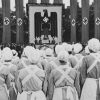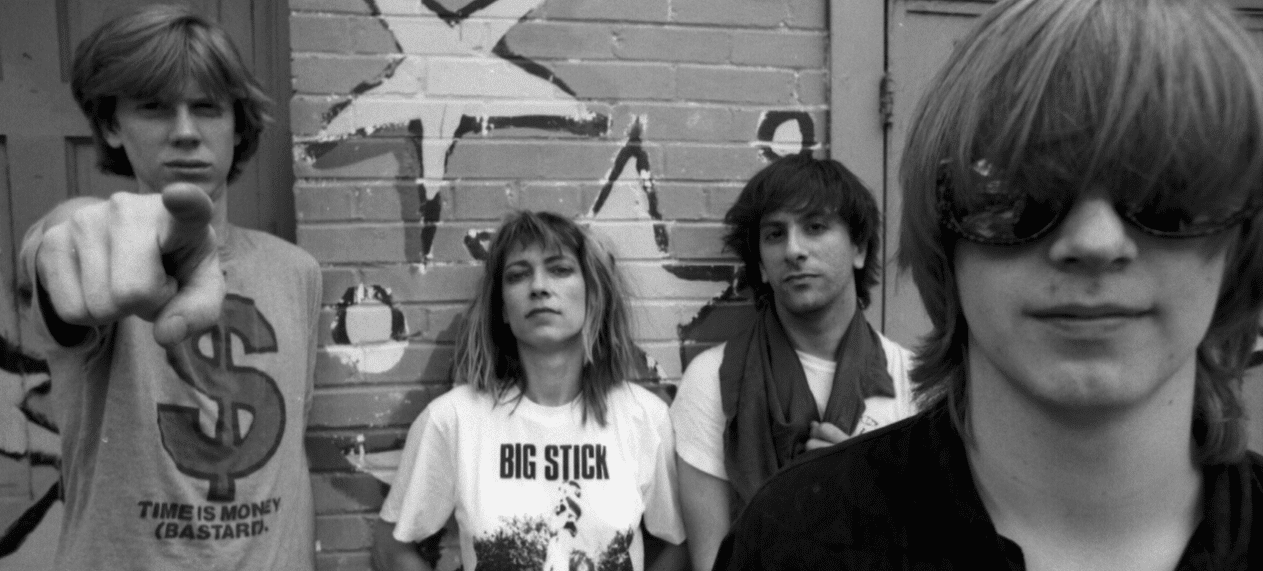Via GQ / Written by STEVE KNOPPER
Every hardcore band you loved in the ’80s and beyond, from Black Flag to Minutemen to Fugazi, had one unfortunate thing in common: Nazi skinheads occasionally stormed their concerts, stomped their fans, gave Hitler salutes in lieu of applauding, and generally turned a communal experience into one full of hatred and conflict. Punk rockers had flirted with fascist imagery for shock value, with the Sex Pistols’ Sid Vicious and Siouxsie Sioux wearing swastikas in public, but, as early San Francisco scenester Howie Klein, later president of Reprise Records, recalls: “Suddenly, you had people who were part of the scene who didn’t understand ‘fascist bad.’”
By 1980, a more violent strain of punk fans was infecting punk shows. “Pogoing became slam-dancing, now known as moshing, and some of ’em didn’t seem like they were there to enjoy the music, as much as they were there to beat up on people—sometimes in a really chickenshit way,” says Jello Biafra, whose band, Dead Kennedys, put out a classic song about it in 1981: “Nazi Punks Fuck Off.”
In the era of Trump and the alt-right, Charlottesville, and “very fine people on both sides,” fighting Nazis is sadly newly relevant, and veterans of the hardcore-vs.-skinheads battles of yore are happy to help with war stories and advice. (Spoiler alert: Most advocate punching Nazis in the face.) Here’s an oral history on how punks took back their scene.
Deek Allen (singer, Oi Polloi): We started in 1981. We had trouble with Nazis from fairly early on, sadly.
Henry Rollins (singer, Black Flag): Some skinheads thought the punk rockers were weak or whatever, so they went to the shows to show them who the real men were.
Mike Watt (bassist, Minutemen): The first time Minutemen went overseas, Black Flag brought us over on tour. We’re playing the Paradiso [in Amsterdam] in February 1983. These guys are all wearing green jackets and big boots and baldhead haircuts. With the sieg-heiling and the saluting. There must have been 20 of ’em… They started giving us the cheers and synchronized maneuvers. And we just kept playing. The way the Minutemen played was just like one big song, so they didn’t really get stuff in there. We were kind of answering them with our songs.
Thor Harris (percussionist, Swans; creator, “How to Punch a Nazi” video): I remember being at shows like Scratch Acid, where skinheads would take over a mosh pit, which is generally a really friendly thing. If people fall down, other people will pick them up. And the skinheads would make it a not-friendly thing.
Rollins: Some of the punk rockers hit back, so that became a thing that went on for years. It was a mix of testosterone, Reagan, ignorance, anger, and youth. Some of these guys were just lightweight followers and would only attack in groups, but a lot of them were genuine bad guys who were into Clockwork Orange–scale violence. It was no joke.
By the mid-’80s, kids who wanted to play rock ‘n’ roll to their friends found themselves in the position of having to put up with crowd wars between Nazis and anti-fascists. To make things especially confusing, both groups shaved their heads, and it was only through a complicated code of color-coordinated shoelaces that anyone could tell them apart.
Rollins: In the Black Flag days, we had skinhead problems in the lower half of America. Florida, especially. One night in 1986, they mugged our soundman, kicked his head in and cut the lines to our PA. The cops came, shut the show down, and told us we were the problem and we had an hour to get over their county line. The skinheads were standing behind them, flipping us off.
Kurt Brecht (singer, D.R.I. [Dirty Rotten Imbeciles]): In Canberra, Australia, it was only a handful of them, but they were disrupting the show and standing in front of us. Everybody was kind of standing around, and that’s when I gave a little rant on stage: “Why aren’t you doing anything?” [People in the crowd responded:] “You guys can leave, but we have to see them around, and they’ll jump us later and scratch our cars.”
Dave Dictor (singer, M.D.C.): It happened on Gilman Street in Berkeley, California, in 1988. [Nazi skinheads] were charging in the club. We were able to push them outside the club. They’d come at you in different ways, with baseball bats, and they had clubs, and they had a Chevy Suburban they’d use like a tank. We literally had open clashes for an hour and a half. Nobody called the police. I was out there with about 10 or 12 people staring down at 30 people. An African-American friend of mine got his collarbone broken. I took a baseball bat and smashed the windshield. They all jumped into it and drove away. They were afraid of their vehicle getting hurt.
Brecht: I decided to let the worst Nazi of all get up on stage, and gave him the mike and let him say what he wanted to say. Of course, he wasn’t very intelligent and he started sieg-heiling and saying racist nonsense or whatever. Our tour manager grabbed a drum stand and walloped him on the back of the head. Once they saw we attacked the Nazi, then everybody else started attacking his buddies out in the audience.
Keith Morris (frontman, Black Flag and Circle Jerks): I witnessed this thing called the Wall of Death in Trenton, New Jersey, at the City Gardens. The skinheads would line up at the back bar and lock arms and run towards the front of the stage, and if you just happened to get in their way, you’d get knocked down, you’d get kicked, you’d get trampled. I leapt off the stage and got in the face of the biggest guy—he probably would have hit me a couple of times, and I would have been in traction in the hospital. I’m ready to get pulverized. I’m ready to just be a puddle, a broken and busted blob of humanity, lying in the middle of this dance floor.
And all of a sudden it’s like the trumpeteers going, “Da da da da da!” Here comes the cavalry. It’s all the bouncers saying, “This thing’s been going on for like six to eight months a year, we just let everybody do what they’re going to do, and people get hurt and leave early and people go to their cars and drive away. We don’t want them here anymore.” Now I’ve got like six bouncers—we’re the Avengers, the Hulk, and Thor and Iron Man.
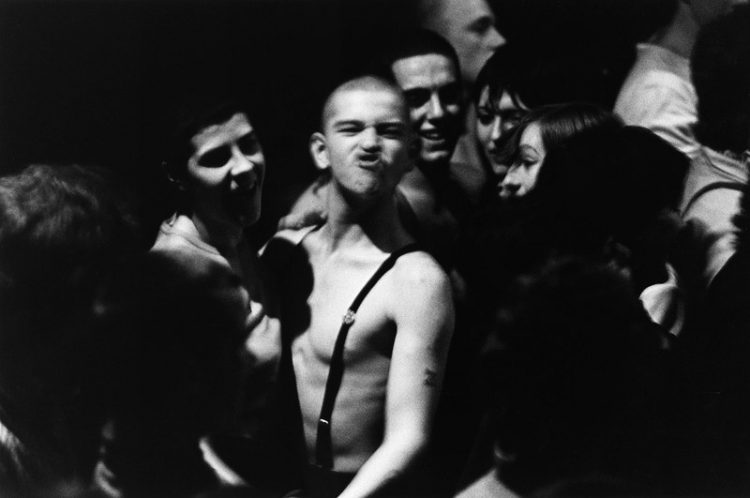
Groups of Nazi skinheads began to coalesce in cities around the world, using clubs such as City Gardens, in Trenton, New Jersey, as bases for their operations. Performers began to identify the ringleaders who caused most of the violence in each city.
Steven DiLodovico (co-author of No Slam Dancing, No Stage Diving, No Spikes: An Oral History of the Legendary City Gardens): You know, half of the Circle Jerks are Jewish, so it’s really insulting. Keith Morris is like 5-foot-2. They’re not big, fighting dudes, but they just didn’t give a fuck. They weren’t going to be intimidated.
Morris: When the bouncers were at my side, the skinheads’ feelings were hurt, their toes had been stepped on. “Oh, woe is me! Poor little me!” At the end of the night, after everybody left, our equipment’s still on stage, we’re celebrating that we made it through another show, and the bouncers were laughing it off. And the owner said, “We’re going to be here at least a couple of hours.” I go and I crack the door open, and I look out in the parking lot, and it’s all the skinheads, they’re in their four or five cars, and they’re driving in circles in the parking lot, waiting for us to come out. A couple hours later, they were gone.
Allen: We were on tour with some Finnish punk bands and we had a gig in Tallinn, the capital of Estonia. The Finns came up to us at the venue: “You’re not going to believe this, there’s this Nazi-bonehead band playing, and they had songs like ‘N—— Get Back to the Jungle.'” And we were like, “What?”
Darryl Jenifer (bassist, Bad Brains): Out of my whole 40 years in Bad Brains, I probably faced racism or heard the word “n—–” maybe a handful of times. Back in the ’80s, we were playing a show in Oklahoma. The little punk-rock kid came up and said, “I love your band, but my boyfriend and his friends are Nazis, they’re going to come down and kick y’all’s ass.” But they never came. That seemed to happen with the Bad Brains. No one came up with us in that “n—–” shit. I’m thinking we’re unique in that. I’d be all around white culture, and it’s just something that didn’t ring to me. And I jumped off tour buses and ran into the Klan’s gas stations.
Allen: There have been gigs where Nazis have turned up and we’ve said, “We’re not playing until these fuckers are out of here.” In this instance, we said, “We’re going to go and talk about this stuff.” We went on, and the first songs we did were about fascism and racism. It wasn’t going down very well…. They hit me and I hit them with a microphone stand, and it turned into a barroom brawl, like in a Western. Most of the locals sat there and watched as if it was entertainment. The only ones who lifted a finger to help were the Russian bar owners who came out from behind the bar with blocks of wood and laid into the boneheads.
David Lowery (singer, Camper Van Beethoven): What we would do was play these fast ska songs. They would kind of run around in circles and skank, and they were happy with us until we started playing something that offended them. I specifically remember playing a Veterans of Foreign Wars or Knights of Columbus hall. We probably had about 800 people in Chico, California, and the crowd kind of turned on us. We were hippies, we had long hair, we played “Wasted” and “White Riot” in this country style, and it just wasn’t going well. We had to play a lot of these fast ska tunes to get them under control. I remember going, “I don’t know if we’re going to make it out of here. I don’t know if we have enough of these fast ska tunes to last the 25 minutes.”
Doug Kauffman (longtime Denver concert promoter): That whole movement was a frightening one to have at a show. The last [Denver punk band] Warlock Pinchers show at the Gothic Theatre, they all came and they were sieg-heiling, and the entire crowd on the main floor just suddenly turned on them. Everybody said, “We’ve had enough of this shit.” All of a sudden, this phalanx of skinheads came running through the front doors and were never seen or heard from again. It was an amazing thing—the crowd just collectively decided, “There’s 700 of us and there’s 40 of you, and we’ve had it.” They ran with their tied-up boots and their gray jackets and their shaved heads, and they ran out of that theater, and I swear to God, it ended the problem.
Rollins: When I had a bunch of overweight teenagers sieg-heiling me, I was unable to take it seriously. I told them that they wouldn’t make it through a week of Army boot camp, much less the Third Reich. They got really mad.
Miraculously, fascist violence at punk shows rarely led to extreme injuries or death. Still, several were injured (and one stabbed) at a 2006 San Bernardino, California, concert in which neo-Nazis reportedly screamed racial epithets and caused a riot of 1,500 people.
Harris: It mostly got policed by the rest of us. We all had our eyes on [skinheads], and if they hurt someone in the mosh pit, quickly we would drag them out and kick them out of the show. If there were bouncers at the club, we definitely would have no trouble convincing them that this skinhead was hurting people. I never saw anybody get really hurt.
Tobin Bawinkel (singer and guitarist, Flatfoot 56): At the Crocodile Rock Café in Allentown, Pennsylvania, there was a skinhead crew there. It was prior to the alt-right thing. We were doing our set, [including a] cover of “We’re Not Gonna Take It” by Twisted Sister as kind of a joke song. Three of the biggest skinheads I’ve ever seen stand in the middle of the pit and start sieg-heiling. I lost it. I started yelling at them and freaking out: “This is not a place you’re welcome at, we don’t want you here, you need to leave.” They just stood there and stared at me. All the bands we were on tour with started to file in behind me with bats and anything they could find, and started glaring. “Hey, Tobin’s faced off against the Nazis! Get up there!”
Brecht: We still get a lot of fights. It’s usually not Nazi skinheads. It’s random people. “You bumped into my girlfriend! And spilled her beer!”
Rollins: When I was able to get the audience to turn on them, it was interesting to often see how upset that made them, like they had no idea how much people hated them. I found this approach to be effective. It’s not for me to instruct someone to go hit someone else, but if I can say something that makes everyone laugh at these guys, it empowers the right people and diminishes the right people.
Lowery: I can’t say we specifically set out to strike a blow against fascist Nazi skinheads, but we were trolling the audience when we first started out, and that was specifically one group we were trolling. So yeah, the ridicule is one part of it. I posted something on Facebook after the Charlottesville thing that some people liked and some people didn’t: “Don’t give these people power by taking them so seriously.”
Allen: Obviously, the situation in America is very different, with regards to weapons. That’s something that isn’t really so much of an issue, thankfully, in Europe. On the other hand, there are general principles that stand up: You’ve got to stand up to bullies…. Speaking personally, members of my family were killed and imprisoned by the Nazis. If you think you can just have a reasoned debate with them, you’re going to be in for a nasty surprise.
Jenifer: One time, I was in Europe and this kid said, “Go home, you fuckin’ Yankee n—–,” and spit on me and spit on my locks. So I jumped off stage. When I stepped back to sock his ass, he was like, “No, mate!” Like, “Damn, my little punk ass is gonna get knocked out!” I can’t say I’d ever see a real troupe of them. The good skins would beat their ass as often. I’ll give you another example. I was going to the bathroom before the club opened. I saw a kid and he followed me. When I came out, he said, “Mr. Jenifer, I want you to know, I used to be a racist, and a skinhead and an asshole, and ever since I saw your band I’m different. I have a wife and kids.” That alone was my platinum record.
Rollins: Now, people should avoid physical confrontation. When I was young, it was a bloody nose, the occasional stabbing. Now it’s a gun under the car seat. When you hit someone, it’s assault and you can go to jail and pay a ton in fines and lawyers. Protesters must realize that a lot of these guys come prepared to goad you into a fight. They’re often more ready than you will ever be. If you start showing up with your helmet and all, then it escalates, and soon someone is going to empty a magazine of rounds into a crowd and it will go from there. I think that’s going to happen anyway, but it shouldn’t be you.

